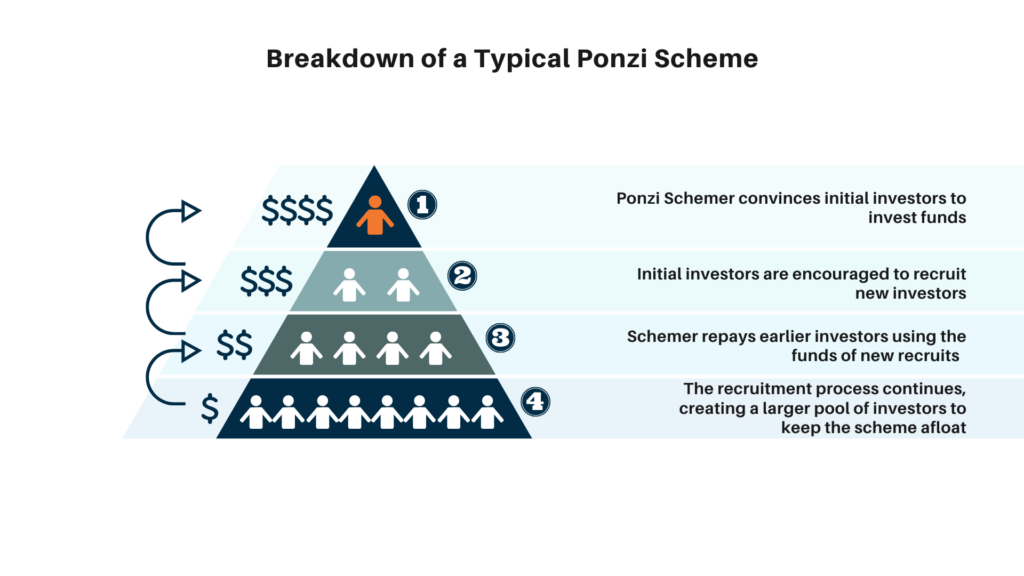The North American Securities Administrators Association (NASAA) has unveiled its list of the top five investment schemes that are likely to threaten investors this year.
Nobody wants to be a victim of investment fraud, so it’s important to be fraud aware.
Let’s take a look at NASAA’s list of investor traps, and learn how to recognize and reject them.
1. Ponzi Schemes
A Ponzi scheme is a common investment scam that promises high returns on investments. It was first used by famous fraudster Charles Ponzi in the 1920s. A century later, this scheme continues to threaten investors in British Columbia.
How the Ponzi Scheme Works
In a Ponzi scheme, existing participants are encouraged to bring in new investors to what is usually a fictional, non-existent investment. Earlier investors are then repaid using the funds of new people who are drawn into this scheme. The scheme typically collapses when the fraudster cannot keep up with repaying investors.

If you’ve been approached about an investment opportunity and it has one or more of these characteristics, it could be a Ponzi scheme.
If you’re unsure about an investment, take some time to do your own research into the company. It’s also a good idea to get an independent opinion from a financial services professional, like an accountant, lawyer or registered investment advisor.
Remember, you should never feel rushed or pressured into buying an investment.
2. Real Estate Investment Schemes
Real estate-based investment schemes can be presented in various ways, but many have a common thread: the promise of earning money fast. Whenever someone is talking to you about “fast money” or “guaranteed, high returns” in an investment scenario, remember the fraud warning signs.
How Real Estate Investing Can Flip Into an Investor Threat
NASAA warns investors about two common real estate investment pitches that could turn out to be fraudulent. One of these pitches is “property flipping,” and the other is “hard-money lending.”
While these are not investment schemes per se, scam artists have used them as pitches to mask their schemes. For example, a fraudster might scam investors who have contributed funds to a property flip by lying about the property’s value, or the expected profits. Invested funds could also be misappropriated.
Like any other investment, there are risks associated with investing in real estate and real estate-based securities. You can learn more about the risks by visiting this page.
3. Crypto Asset Investments
Entering into the world of crypto is often viewed as, well, cryptic. Why? Crypto assets are considered high-risk because of their speculative nature. When a person is speculating on a crypto asset, they are generally focused on trying to profit from changes in the crypto asset’s market value.
Crypto assets include cryptocurrencies, blockchain companies, cryptocurrency funds, and are often sold by initial coin offerings (ICOs). Learn more about these products and the associated risks.
Many people use the term “cryptocurrencies” when referring to crypto assets. However, while many crypto assets are digital mediums of exchange (and therefore act similar to currencies), not everything that is referred to as a cryptocurrency is a digital medium of exchange, but could be a crypto asset with other properties.
It’s important to keep in mind that the BCSC and many Canadian securities regulators urge caution when buying crypto assets through trading platforms.
4. Promissory Notes
A promissory note, also known as a corporate note, is an unconditional promise made by a borrower to repay the borrowed money and pay interest by a specific date (or set of dates) in the future.
Promissory notes are not risk-free and are only as good as the companies or projects they are financing. Legitimate promissory notes generally pay interest, either periodically before maturity of the note or at the time of maturity, offering investors a predicable return on their investment.
There are various risks involved with this type of investment.
Be Wary of Short Terms and High Returns
In particular, NASAA warns investors to be cautious about promissory notes that have short-term durations (ex: nine months or less) with promises of high returns. Generally, if the investment sounds too good to be true, it probably is.
Get advice from a registered investment advisor, accountant, or legal professional before purchasing this type of investment.
5. Investment Fraud via Social Media
Social media gives us plentiful opportunities to connect to others and share content worldwide with ease. Con artists use these same social perks to promote fraudulent investment opportunities. Social media provides them with access to personal information to target potential investors and even create the illusion of a shared common interest.
Protect Yourself Against Online Fraud with Traditional Methods
NASAA points out that online investment scams often have similar characteristics to offline scams. Fraud awareness is key to protecting yourself and your loved ones from the devastating impacts of investment fraud.
Become more fraud aware by familiarizing yourself with the fraud warning signs:
- High Return | No Risk | Guaranteed
- The Trust Trap
- Fear of Missing Out
- Pressure to Buy
- Questions Not Answered
Learn more about what each of these fraud warning signs mean.
You can also take our free e-mail course to learn more about common investment scams and how to spot them.
Report a Concern
If you have any concerns about a person or company offering an investment opportunity, please contact BCSC Contact Centre at 604-899-6854 or 1-800-373-6393 or through e-mail at [email protected]. You can also file a complaint or submit a tip anonymously using the BCSC’s online complaint form.
InvestRight.org is the BC Securities Commission’s investor education website. Subscribe to receive email updates from BCSC InvestRight.

